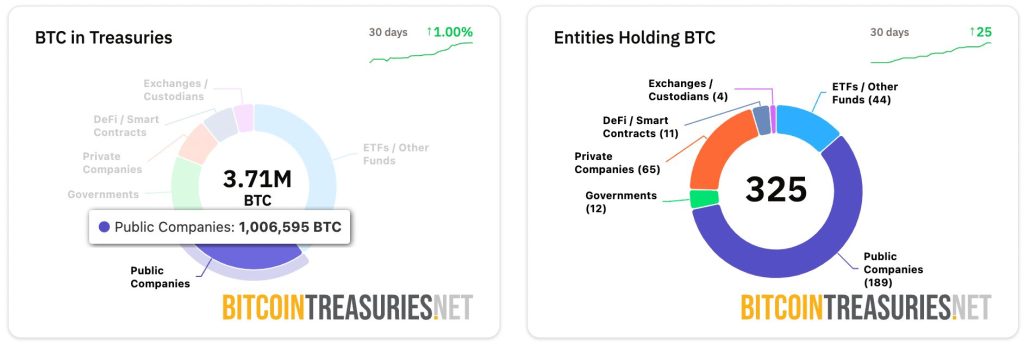The Crypto corporate treasure movement has reached a critical turning point, moving from an era of premiums guaranteed to what Coinbase Research calls a competitive phase of “players against the player.”
Public companies now have more than 1 million bitcoin worth $ 110 billion, with digital asset account bonds that control $ 215 billion in 213 entities.
However, new research warns that most participants face a possible failure during adverse credit cycles.
The strategy leads the corporate cryptographic movement despite the growing pressures
Microstrategy, now operating as INC strategy, leads the package with 638,460 BTC after registering $ 14.05 billion in profits not made during the second quarter of 2025.
The company’s aggressive accumulation strategy inspired dozens of imitators, but the first moves as the strategy enjoyed substantial premiums to the value of net assets that have since compressed under competitive pressure.
The transformation began in 2020 when Michael Saylor’s strategy was a pioneer in the corporate Bitcoin Treasury model using convertible bonds and capital increases.
Mining companies such as Mara Holdings continued with 52,477 BTC, while newcomers like Jack Mallers’ XXI accumulated 43,514 BTC, and Metaplanet of Japan pointed to 210,000 BTC by 2027.
However, space has changed fundamentally. Nasdaq hardened the supervision requirements for the Treasury Bonds of Digital Assets, demanding the approval of the shareholders for certain transactions.
The strategy abandoned its self -imposed threshold of 2.5x market market for the sales of shares after financing pressures were mounted, while they face multiple class action demands on commercial practices.
Coinbase Research identifies this transition as going beyond simple Microstrategy imitation strategies towards execution dependent.
The scarcity premium that benefits the first users has dissipated, which forces companies to differentiate through strategic positioning instead of simply accumulating Bitcoin.
Treasury bonds face structural vulnerabilities in the growing rates environment
At the beginning of last month, Sentora Research identified critical failures in Bitcoin’s corporate strategies, warning that “Bitcoin inactive in a general balance is not a scalable strategy in a world of ascending rate.”
Most Bitcoin treasure companies operate as non -profitable entities or depend largely on marking profits for the market for solvency.
The strategy reflects the historical construction of wealth through the leverage acquisition of scarce assets, but lacks the evolution of bitcoin of digital property to capital generating capital.
Unlike real estate, which generates rental income, Bitcoin Treasury companies participate in negative transport operations, borrowing fiduciary currency to acquire non -winners without adequate risk mitigation mechanisms.
The strategy uses $ 3.7 billion in convertible bonds of ultra -low coupon and $ 5.5 billion in preferred perpetual shares to finance acquisitions.
Similarly, Metaplenet continues its aggressive accumulation, doubling Bitcoin holdings every 60 days while using convertible zero interest bonds worth ¥ 270.36 billion.
The company recently ended its sale of shares of $ 1.45 billion to finance mass purchases of Bitcoin, issuing 385 million shares with scheduled settlement for September 16.
The increase in interest rates amplifies the negative transport effects, while Bitcoin’s stagnation for 2-3 years could erode the conviction and make capital issuance dilutive.
Nueva participants regulatory saturation and scrutiny challenge
Glassnode James Check analyst has previously raised concerns about the longevity of the strategy, arguing that easy profits have disappeared for new participants as markets mature.
Bitcointreeuries data show that the new entities that add BTC holdings to scale come together every month, but investors are increasingly expecting a clear differentiation beyond the basic accumulation of Bitcoin.
The Cryptographic Analyst Ran Neuner said that many treasure companies operate as exit vehicles for experts instead of genuine market buyers.
Companies often receive cryptographic contributions from existing holders in exchange for shares that are subsequently negotiated with mass premiums, allowing the first taxpayers to be charged, while retail investors pay 2-4x net asset value.
Financial Times reported in August that 154 companies contributed in the United States raised $ 98.4 billion for cryptography purchases in 2025, more dramatically $ 33.6 billion raised by 10 companies previously.
Just this month, Forward Industries raised $ 1.65 billion for the sole -based treasure bonds backed by Galaxy Digital and Jump Crypto, while Ethereum Holdings Corporate reached $ 28 billion in multiple entities.
Despite being the leading company, the strategy was recently denied the inclusion of S&P 500 despite complying with the technical criteria, and the Index Committee expressed concerns about the heavy commercial models of Bitcoins and the risks of high volatility.
The broader movement faces warnings that participants cannot survive credit cycles due to structural vulnerabilities in environments with increasing interest rates.
However, Coinbase Research maintains a constructive perspective for large capitalization cryptography names that benefit from the continuous Dex capital flows.
Coinbase Research argues that the increase in competition forces companies beyond the simple copy of microsthegias, potentially promoting the most strategic capital allocation and sustained purchase pressure as companies compete for investors’ attention.
The era after Crypto Treasury’s treasure ends as companies enter the competition of players versus players’, well for investors? It appeared first in Cryptonews.

